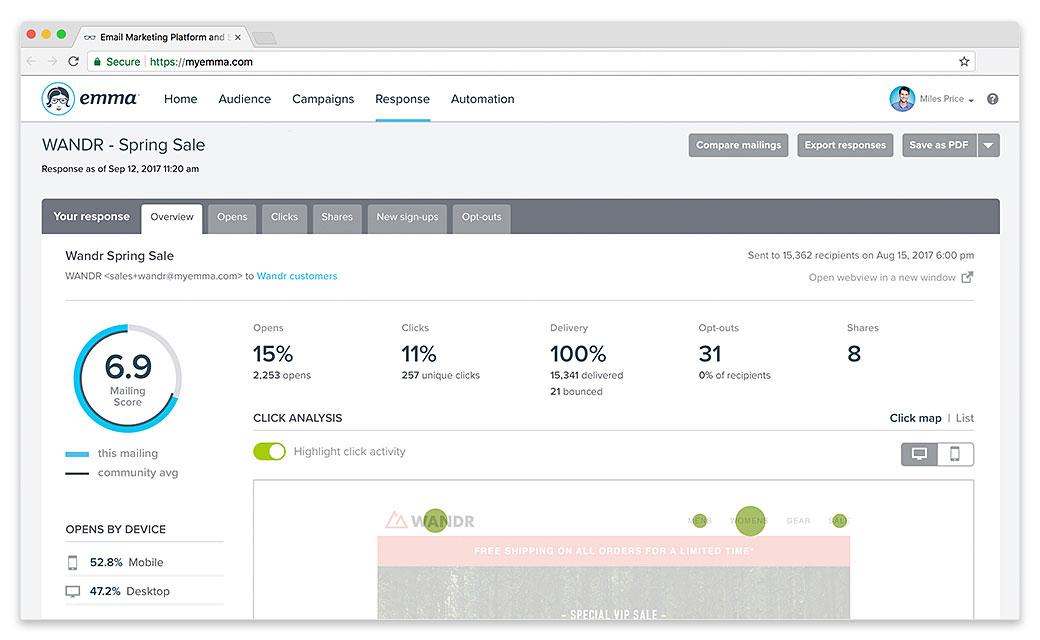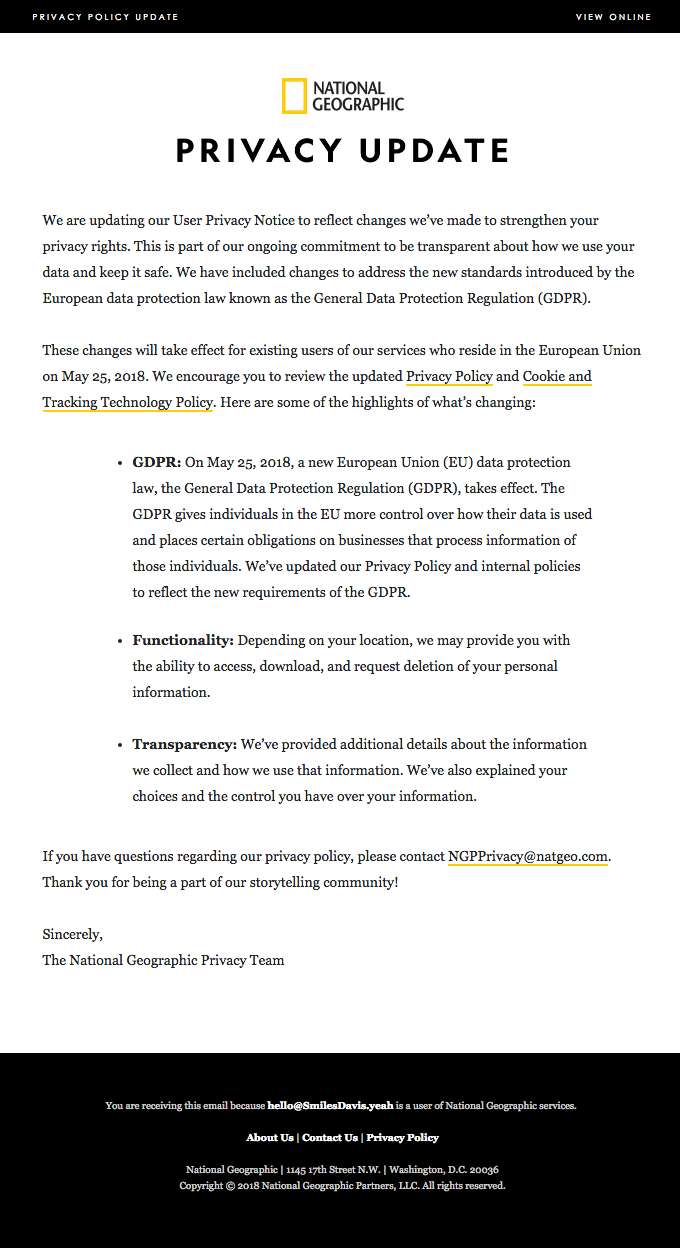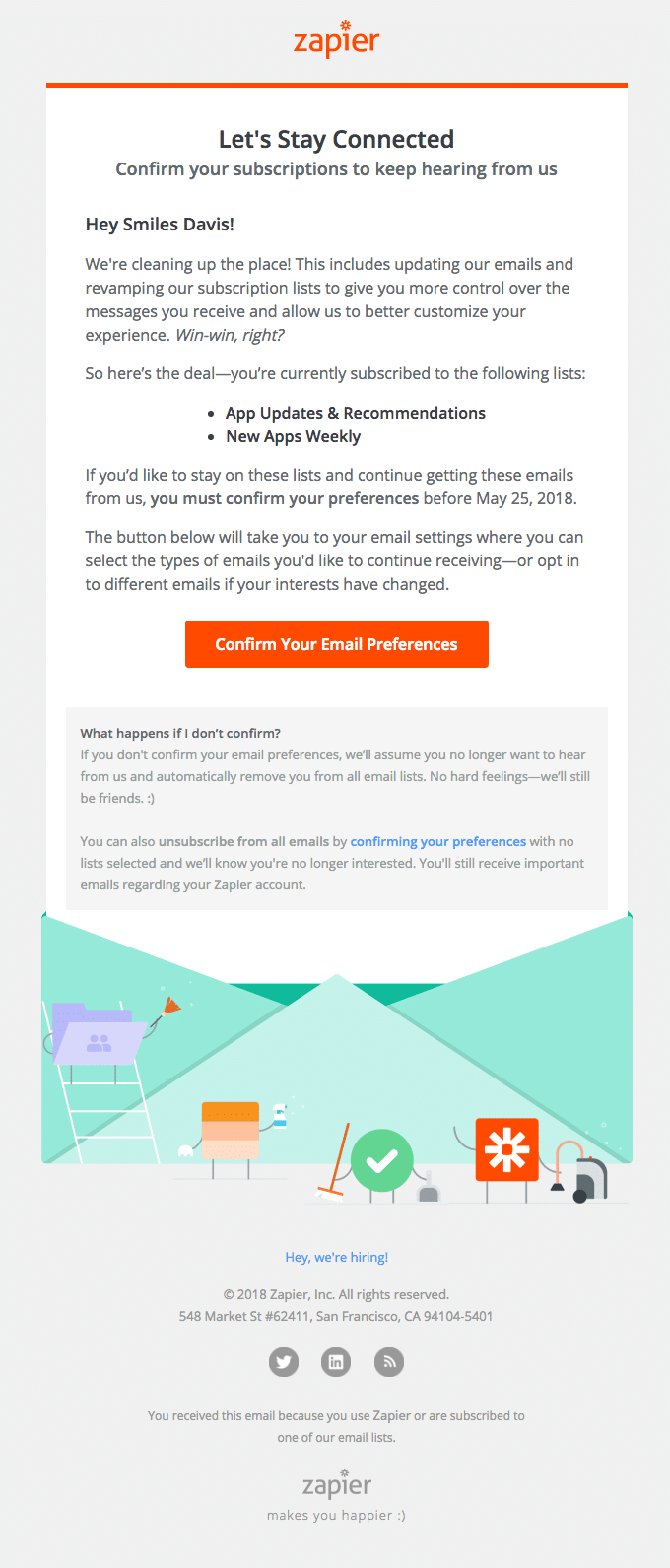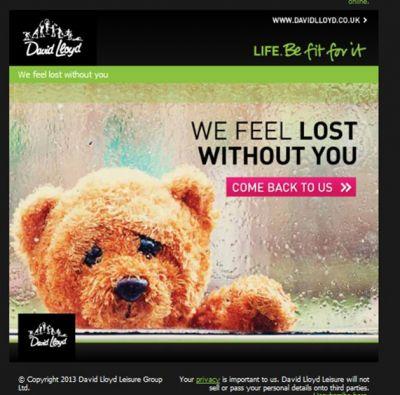Why you should think twice before removing the unsubscribe button

There are 3.9 billion email users worldwide and you want to connect with all of them—right?
Numbers matter—especially when it comes to marketing. Oftentimes, the more followers and website visitors you have will translate into a higher revenue boost because there are more eyes on your brand. For this reason, many email marketers may be tempted to remove unsubscribe buttons to hold subscribers hostage on their list.
However, with email marketing, more is not always better. Sure, you may be tempted to purchase distribution lists or collect endless email addresses at networking events, but this might not impact your ROI and could even have a negative effect on your audience.
If you’re considering removing the unsubscribe button from your email campaigns, consider the points outlined in this post as reasons why it’s not advantageous to your strategy. Don’t worry—we’re here to help!
What is the unsubscribe button?
Before you learn why the unsubscribe button is so crucial to a digital strategy, it’s important to understand what it is and why people use it. An unsubscribe button is an action a user takes to opt-out of receiving any more email communication.
Emma provides detailed reporting on how many unsubscribes occur after each campaign that is sent. By analyzing these results, you can derive important information to improve future campaigns like testing subject lines, content, templates, and more.
Why do people unsubscribe?
Typically speaking—the more unsubscribes you receive, the more disinterested your contacts are in your brand. While the reason will vary between the individual subscribers, there are four main reasons people unsubscribe:
-
You’re sending too many emails—every day or multiple times a day—and your subscribers consider you ‘spammy’.
-
You’re constantly pressuring your subscribers to purchase your product instead of helping solve their problems.
-
Your content is irrelevant, boring, and impersonalized to your audience.
-
Your emails are not mobile optimized and are displaying incorrectly.
If you’re experiencing an increasing unsubscribe rate, it may be time to reevaluate your email marketing strategy before you remove the unsubscribe button. You can personalize your content, utilize a double opt-in system, and engage your contacts with content that matters to them.
5 reasons why keeping the unsubscribe button helps you send better emails
When developing your email marketing strategy, it’s crucial to focus on content quality and engagement. Quantity just doesn’t equal quality the same way it does in other digital techniques.
Consider these five reasons why keeping the unsubscribe button actually helps you send better emails that will result in higher conversions.
Focus on subscribers who want to hear from you
One of the most important reasons to keep the unsubscribe link is that it allows you to focus on subscribers who are interested in your content. The truth is—you don’t earn any benefits from inactive subscribers who are sitting in your list and receiving your emails but not opening or clicking them. In fact, it will negatively reflect on your email metrics.
Unsubscribes will help you maintain a healthy and quality distribution list so you can better segment your audiences to deliver hyper-personalized content. The more personalized content you can deliver—including regional information, purchase history, past behavior, etc.—the more likely you are to build a long-lasting relationship with your audience that converts.
Follow unsubscribe laws
Utilizing the unsubscribe link is regulated by anti-spam laws set in different countries throughout the world. With the recent 2018 GDPR law, email marketers need to be even more aware of following the guidelines to stay compliant and avoid hefty fines.
Different laws include:
-
USA: CAN-SPAM Act
-
Canada: Anti-Spam Law
-
United Kingdom: Privacy and Electronic Communications Regulations
-
European Union: General Data Protection Regulation (GPDR)
While these laws are all different, they essentially grant data protection from brands. For example, the CAN-SPAM regulates commercial communication and protects against users receiving spam and the GDPR helps control user’s personal information from being distributed without consent. It’s important to note that even if you are a brand in the USA—you have to follow the GDPR laws if you send communication to subscribers in those regions.
In good practice, it’s recommended to adhere to all these regulations to ensure you are in compliance.
Source: Really Good Emails
Keep your email reputation high
Including an unsubscribe button means that your emails are less likely to end up in the dreaded spam folder. Think of it this way—if you remove the unsubscribe link and someone doesn’t want to receive your emails, the logical next step is to report your messages as spam. Once you are marked as spam, your subscribers will never see or engage with your emails again.
Unfortunately, every time your email is sent to the spam folder has a negative effect on your email sender reputation. Email providers consider your sender reputation before determining if your email will appear in your subscriber’s inbox. Factors like email content, engagement, and spam reports all influence your score and determine your reputation. Meaning, even if you aren’t marked as spam but you have a lower score—you might not appear in any inboxes.
Improve customer experience and avoid frustration
You know this feeling—you sign up for brand’s newsletter to receive a shipping discount on a whim—and you start receiving endless emails that don’t pertain to you anymore. It’s frustrating and can be even more annoying if you can’t figure out how to unsubscribe.
By including the unsubscribe link, you create a more positive experience for the email user by providing them the opportunity to have an inbox full of wanted content. Understanding your customer’s needs and preferences is the first step in earning their trust, loyalty, and hopefully, their reengagement.
If a user decides to unsubscribe from your list, send a confirmation email asking for more information on why they made this decision. This feedback is crucial in improving future email campaigns to meet your audience’s needs and it also you have the opportunity to ask them to opt-in again.
Develop preference centers to learn more
If you’re still weary on including the unsubscribe link, consider developing a preference center for your subscribers to control your communication better. A preference center helps to increase overall customer satisfaction, retain more subscribers, and reduce the amount of unsubscribes in general.
Why? You have the opportunity to learn about your subscriber’s needs to deliver more relevant and personalized email. By offering them control of your communication, they will be more apt to stay subscribed and actively engage with your brand.
In the preference center, users should have the option to opt-in or out, choose the frequency of emails, and decide which type of content they want to hit their inbox.
Source: Really Good Emails
How to re-engage inactive subscribers
Now that you understand why it’s important to keep the unsubscribe button in all your email marketing campaigns, you need to learn how to reengage inactive subscribers. While these subscribers haven’t taken the step to unsubscribe, they’re not opening, clicking, or converting from your email messages—which again, doesn’t benefit your strategy.
Once you identify who those inactive subscribers are, you will want to:
-
Tell your subscribers you miss them: Customers want to feel special and honestly telling them that you have noticed they dropped engagement could increase your click-through rates by 14%. You can even include an incentive—like a discount—to come back.
-
Create a feedback survey: Pinpoint exactly why they aren’t engaging anymore with a feedback survey. This offers them a great chance to interact with your brand, and you will gain valuable knowledge on how to win them back.
Source: Emma
Whether your subscribers are sleeping on your messages or actively engaged—you want to create meaningful relationships with them all to build loyalty and convert. These re-engagement strategies will help you determine if you can earn their trust once more—or if they are truly inactive.
Wrap up
If you’re still planning to remove unsubscribe buttons from your email marketing campaigns—we recommend utilizing this button as an opportunity to provide more meaningful campaigns. While it may sound like a failure to lose subscribers and potential customers, the unsubscribe link helps you determine how to send emails that are engaging and relevant to the right people.
Before you press ‘delete’, consider the following:
-
You have the ability to focus on the subscribers who are your potential brand advocates
-
You will adhere to national and global regulations
-
Your email reputation will stay high and you will avoid the spam folder
-
You can provide a positive customer experience to all subscribers
-
You can create email preference centers to learn more about your subscribers
Are you wondering what else is included in a successful email strategy? Check out our step-by-step checklist to help you gain more ROI out of every email campaign!
MOST RECENT ARTICLES
Want to engage your audience and grow your brand? Try Emma's robust easy-to-use product today.
















